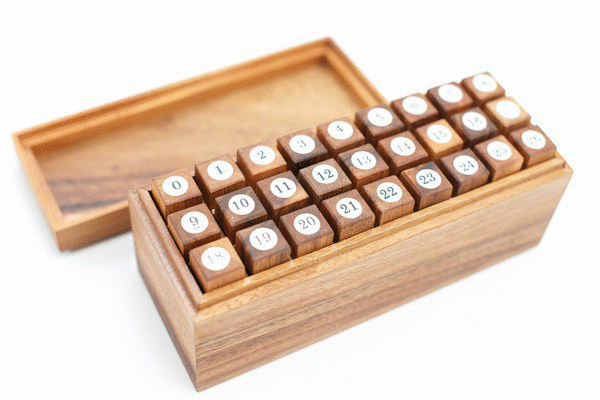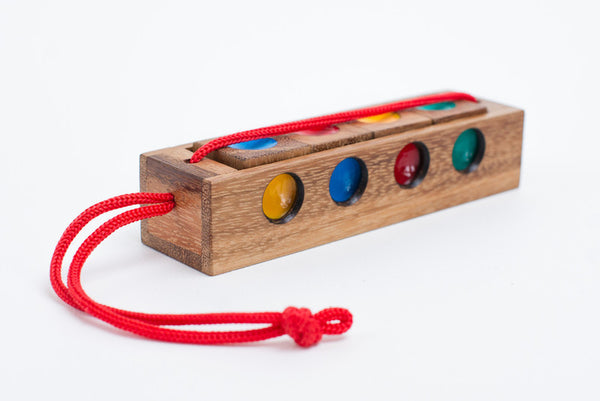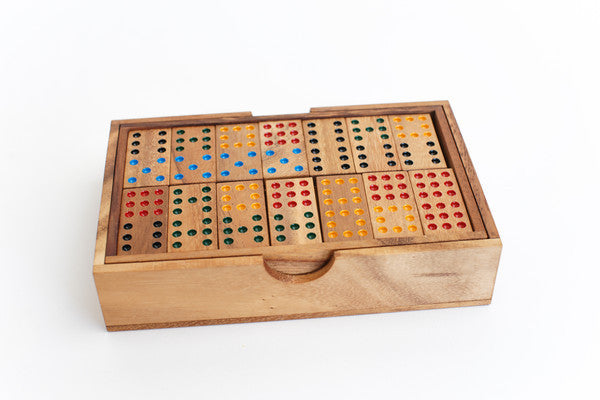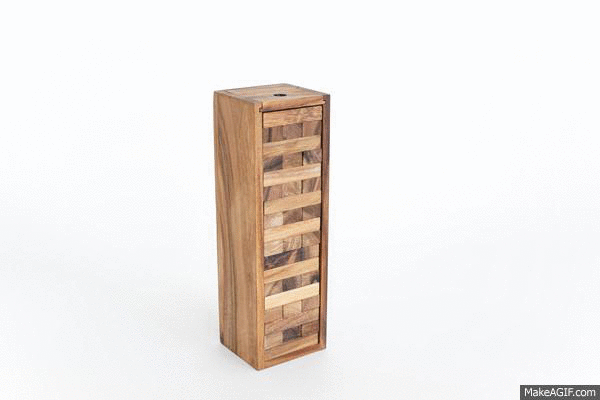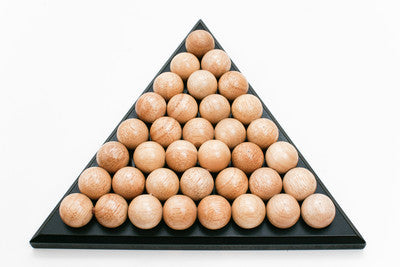Colored Gentle Tower - Wooden Stacking Game
Sold Out
The classic stacking game can be played in 2 variations:
1. Classic- without taking in consideration the colored pieces.
2. When a color direct your move.
Each turn a player rolls the colored die and then must remove a piece of the color shown.
This game uses standard Jenga rules. Once a piece is removed it is placed on top of the stack. Pieces may only be removed from the top of the stack once there are at least 3 full rows completed over them. The game is over when the tower falls.
Combination Burr Box - Brain Teaser Wooden Puzzle
Sold Out
In this special box you can find 27 wooden rods.
All of them have the same size, but are sliced differently inside.
To create a burr puzzle (interlock puzzle that has 2 rods on each side), you will need any 5 different rods + the 0 (zero) rod- which is the only fully squared rod.
Crazy Four - Brain Teaser Wooden Puzzle
$15.99
A classic game that has been teasing puzzlers for generations, can you eliminate the redundant sides?
Three puzzles in one:
1. Take the cubes out from the case, mix them up, and then rearrange them (in the case) so there are four different colors on each side.
2. Arrange the cubes out from the case in a 2X2 square, so there are four different colors on the top, the same four different colors on the bottom and two different colors on each side.
3. Arrange the cubes out from the case in a 2X2 square, so there are four different colors on the top, the same four different colors on the bottom and two of the same color on each side.
Domino 12 - Wooden Game
$38.99
There are countless different domino games and within each game, there are many variations of play available. The purpose of this set of rules is to get you started with a few simple and popular games.
One of the wonderful things about dominoes is that anyone can learn the basics very quickly, but as you play and progress, you will find many additional levels of the game and as your experience and skills develop, you will become a more and more formidable player. Get started with these simple games and you will find yourself getting smarter every time you play. Dominoes is a good game for your brain.
Domino 15 - Wooden Game
Sold Out
There are countless different domino games and within each game, there are many variations of play available. The purpose of this set of rules is to get you started with a few simple and popular games.
One of the wonderful things about dominoes is that anyone can learn the basics very quickly, but as you play and progress, you will find many additional levels of the game and as your experience and skills develop, you will become a more and more formidable player. Get started with these simple games and you will find yourself getting smarter every time you play. Dominoes is a good game for your brain.
Domino 9 - Wooden Game
$35.99
There are countless different domino games and within each game, there are many variations of play available. The purpose of this set of rules is to get you started with a few simple and popular games.
One of the wonderful things about dominoes is that anyone can learn the basics very quickly, but as you play and progress, you will find many additional levels of the game and as your experience and skills develop, you will become a more and more formidable player. Get started with these simple games and you will find yourself getting smarter every time you play. Dominoes is a good game for your brain.
Double Soma Cube - Wooden Puzzle
Sold Out
The Soma Cube was invented during a lecture on quantum mechanics. This puzzle brings the fun and challenge of tangrams into the 3rd dimension.
Each Soma Cube is made of seven pieces which must be assembled into a 3×3×3 cube. The pieces can also be used to make a variety of other 3D shapes.
The Double Soma Cube is two players puzzles. It includes two sets of Soma Cubes and one set of cards. The cards represent 4 levels of challenges.
Gentle Tower
$34.99
The Gentle Tower game made from our beautiful Monkey Pod wood from Thailand.
Players take turns removing one block at a time from a tower constructed of 54 blocks. Each block removed is then placed on top of the tower, creating a progressively taller and more unstable structure. The player before the person who knocks over the tower wins. Same rules as the classic Jenga.
Golden Triangle - Wooden Puzzle
Sold Out
With 3 different objectives this is the perfect game for any coffee table. See how many solutions you can find for the triangle and the two three dimensional pyramids.
The triangle can be filled any of 24 ways, and once complete the pieces can be used to make a 4x4x4 pyramid using 20 balls and a 5x5x5 using all the pieces except the single ball.
Heart Tangram - Wooden Puzzle
Sold Out
The Tangram is a dissection puzzle consisting of seven flat shapes, called tans, which are put together to form shapes.
The objective of the puzzle is to form a specific shape (given only an outline Select one card out of 42 and build the shape, using all parts of the tangram.
Othello (Reversi) - Wooden Game
$22.69
Named after the Shakespeare play due to its traditional black and white pieces Othello was invented in England in the late 1800's. Designed as a simplified version of Go, Othello (or Reversi) offers a fun challenge for all ages.
Initially the board is empty except for 4 pegs - 2 of each color- placed in the central square on opposing corners. On each turn a player places a peg of their color onto the board in such a way as to capture one or more of the opponent's pegs, if you can't capture a peg you must skip your turn. Pegs are captured when a peg placed on the board sandwiches one or more of your opponents pegs between two pegs of your own color. Pegs can be captured horizontally, vertically and diagonally.
The game is over when the board is full or neither player can move, the player with the most pegs of their color wins.
The board allows you to play another Game: Solitaire.
At the beginning of the game the peg in the center of the board is removed. Moves are made by jumping a peg over an adjacent peg, removing each peg as you pass over it. The aim of the game is to remove all the pegs until only one peg is left in the center of the board.
Step On Me (Challenging Connect 4) - Wooden Game
$54.00
Content:
° Main board with 16 holes
° Two stands for the game pieces with 12 holes each
° 24 Wooden cylinders (the game pieces), varied in color and size.
Each player starts the game with 4 long wooden cylinders and 8 short cylinders (half the length of the long cylinders)
Objective:
To create a row of four cylinders of the same color, visible on the surface of the board, in either a straight or diagonal line.
Preparations:
l. Remove the two stands from the main board, and reattach them to the sides of the main board horizontally.
2. Remove the cylinders from the main board and divide them between the two players according to color. The cylinders must then be arranged on the two stands. The four long cylinders must be placed in the front row (the closest to the main board) and the short cylinders in the rest of the stand.
3. The two players then sit in front of one another with the board between them. Make sure that each player can only view her/his own cylinders, while not viewing the opponent's cylinders. Also, during the game, the opponents must not view the main board from above (thus revealing the arrangements of the short cylinders on the board).
4. Prior to commencing the game, each player must place on the main board one of the small cylinders, without the opponent knowing where the piece is (each opponent looks away while the player places one small cylinder, so the location of it won't be revealed)
5. The starting player will be chosen by a draw.
Process of the game:
Each player, in her/his turn, must place one cylinder on the main board.
° lf the cylinder is long, it will be visible on the surface of the main board.
° lf the cylinder is short, it will "disappear" inside the main board. Try to remember where the small cylinders are placed as the game progresses.
° When a small cylinder is placed in a hole which already contains another small cylinder, the second cylinder will be visible on the surface of the main board.
° lf a long cylinder is being placed in a hole which already contains a small cylinder, the long cylinder will stick out from the main board. lf this happens, the long cylinder is immediately disqualified and that opponent forfeits the game.
° Please remember that the main board is being "booby-trapped" at the beginning of the game, and the use of long cylinders is thus not safe.
The first player to create a row of four cylinders visible on the surface of the board, in either a straight
or diagonal line, wins the game.
Tangram (2 x 7 Pieces)- Wooden Puzzle
$39.99
The Tangram is a dissection puzzle consisting of seven flat shapes, called tans, which are put together to form shapes. The objective of the puzzle is to form a specific shape (given only an outline). Here you have a double set of Tangrams with 61 different challenges representing all levels. This game suits single or two players. You can race another player to see who can build the same shape first!





